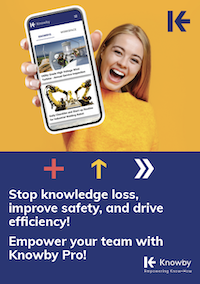Employee Onboarding Process: A Step-by-Step Guide for Success

March 15, 2025

Employee onboarding is a critical process that sets the foundation for a new hire’s success within an organisation. A well-structured new employee onboarding process not only enhances employee engagement but also improves retention, productivity, and overall job satisfaction.
In this guide, we’ll break down the employee onboarding process, provide an employee onboarding checklist, highlight best practices, and show how Knowby can help simplify and enhance onboarding with its intuitive employee onboarding training software.
Table of Contents |
What is Employee Onboarding?
Employee onboarding is the structured process of integrating new hires into an organisation. It goes beyond simple orientation, ensuring employees receive the necessary tools, training, and support to become fully productive in their roles. A well-designed onboarding process ensures that new employees feel welcome, confident, and prepared to contribute effectively. Hiring managers play a crucial role in organising and executing the onboarding process, ensuring new hires receive the necessary tools and support to succeed.
Why is Employee Onboarding Important?
A strong onboarding process directly impacts employee satisfaction and retention. Studies show that organisations with an effective onboarding program experience:
- Higher retention rates – Employees who go through structured onboarding are 58% more likely to remain with a company for three years.
- Increased productivity – Proper onboarding reduces ramp-up time, allowing employees to contribute faster.
- Greater job satisfaction – Employees who feel supported and well-trained are more engaged and motivated.
Additionally, effective onboarding helps new hires integrate into the company's culture, making them feel more connected and engaged within the organisation.
Step-by-Step Guide to the Employee Onboarding Process
A structured and comprehensive onboarding process helps ensure that new hires feel welcomed, supported, and set up for success. Below is a detailed eight-step onboarding guide, aiming for a smoother transition:

Step 1: Preboarding Preparation (Before Day One)
Preparation before a new employee’s first day sets the tone for their onboarding experience. It is crucial to start preparations 1-2 weeks before a new employee's first day, including getting their paperwork ready, setting up online accounts, and ensuring that their technology is in place for a smooth onboarding process.
✅ Send a welcome email with key details about their first day.
✅ Provide access to necessary documents (contracts, policies, benefits, etc.).
✅ Set up IT accounts, email, and workstation before their arrival.
✅ Assign an onboarding buddy or mentor for guidance and support.
✅ Give access to an employee onboarding checklist to help them prepare.
Step 2: Orientation & First-Day Essentials
The first day should make employees feel comfortable, connected, and excited about their new role.
✅ Host a welcome session with HR and key team members.
✅ Provide an overview of company mission, values, and policies.
✅ Offer a tour of the workplace (or a virtual walkthrough for remote employees).
✅ Set up payroll and benefits enrolment.
✅ Prepare and review new hire paperwork including tax forms, contracts, and payroll information.
✅ Introduce company communication tools and collaboration platforms.
Step 3: First Week Onboarding
The first week of onboarding is a critical period for new employees to settle into their roles and become familiar with the company culture. During this week, the focus should be on providing new employees with the necessary tools, information, and support to perform their job duties effectively.
Here are some key activities to include in the first week onboarding process:
- Job Shadowing: Arrange for new employees to shadow experienced colleagues to gain a deeper understanding of their job responsibilities and the company’s operations.
- Training Sessions: Provide new employees with comprehensive training sessions on the company’s policies, procedures, and software systems.
- Meetings with Key Team Members: Schedule meetings between new employees and key team members, including their supervisor, colleagues, and other stakeholders.
- Company Tour: Give new employees a tour of the company’s facilities, including the office layout, meeting rooms, and other common areas.
- Introduction to Company Culture: Provide new employees with an overview of the company culture, including the company’s mission, values, and expectations.
By the end of the first week, new employees should have a clear understanding of their job responsibilities, the company culture, and the expectations of their role.
Step 4: Role-Specific Training & Expectations
Employees should receive job-specific training and understand what’s expected of them.
✅ Assign department-specific training modules covering core job duties.
✅ Review performance expectations, KPIs, and success metrics.
✅ Encourage manager and mentor interactions for role-specific guidance.
✅ Assign shadowing opportunities with experienced colleagues.
✅ Provide a roadmap for the first 90 days, so employees know their progression plan.
✅ Emphasize the importance of understanding team processes to enhance communication and facilitate new employees' integration during onboarding.
Step 5: Tools & Technology Training
Ensuring employees are confident in using the right tools is essential for productivity.
✅ Provide hands-on training for key software, tools, and systems.
✅ Introduce process documentation and SOPs for daily operations.
✅ Give employees access to Knowby’s employee onboarding software for interactive, step-by-step learning.
✅ Conduct a tech check to ensure employees have all necessary hardware and software.
Step 6: Performance & Feedback Checkpoints
Regular check-ins and structured milestones help employees stay on track.
✅ Implement a 30-60-90 day plan to structure learning and performance expectations:
- First 30 Days: Training, shadowing, and understanding company culture.
- Days 31-60: Taking on independent tasks with guidance.
- Days 61-90: Increased autonomy, performance reviews, and career discussions.
✅ Schedule weekly check-ins with managers to track progress.
✅ Encourage employees to provide feedback on their onboarding experience.
✅ Recognise early accomplishments to build confidence and motivation.
Step 7: Integration into Company Culture & Team
Beyond job training, employees should feel connected to their team and the company’s culture.
✅ Organise team-building activities to foster relationships.
✅ Encourage participation in company-wide initiatives and social events.
✅ Assign employees to cross-department collaboration projects.
✅ Provide access to business process documentation for seamless knowledge sharing.
✅ Implement a structured onboarding process for new team members to ensure they feel welcome, empowered, and equipped with the necessary skills and information for their roles.
Step 8: Continuous Learning & Career Development
The best onboarding processes extend into long-term professional growth.
✅ Offer ongoing learning opportunities such as training refreshers, mentorship programs, and career development resources.
✅ Provide structured upskilling opportunities through Knowby’s interactive training modules.
✅ Conduct quarterly performance reviews and goal-setting meetings.
✅ Encourage employees to explore growth paths and internal promotions within the company.
Streamline Onboarding with Knowby
Accelerate employee training with interactive digital guides 🚀
Best Practices for a Successful Employee Onboarding Process
1. Use an Employee Onboarding Checklist
A structured checklist ensures every step is completed systematically. Key items include:
- Pre-boarding activities (IT setup, paperwork, welcome email).
- Preparing for a new hire's first day (setting up their workspace, ensuring access to necessary tools).
- First-day orientation (introductions, company overview, compliance training).
- Initial training and mentorship to ensure clarity on job expectations.
- Performance expectations and goal setting for early alignment.
- Continuous feedback and engagement to keep employees motivated.
2. Personalise the Experience
Customise onboarding based on the employee’s role, experience, and learning preferences to make it more effective.
- Role-Specific Training: Provide customized learning paths based on job responsibilities. For example, a software developer may need coding environment setup and tool access, while a sales associate may require CRM training.
- Individual Learning Styles: Some employees learn best through hands-on practice, while others prefer visual or text-based training. Offering multiple learning formats (videos, interactive guides, in-person coaching) enhances engagement.
- Pace Adjustment: Some employees may adapt quickly, while others may need more time. Allow flexibility in training schedules.
- Custom Mentorship Pairing: Assign mentors or buddies who align with the new hire’s role and career goals to foster stronger connections.
- Company Culture Fit: Share company stories, values, and success stories that resonate with the employee's background and interests.
3. Leverage Employee Onboarding Software
Using a digital onboarding solution like Knowby simplifies training, ensures consistency, and enhances engagement.
- Standardized Training: Digital platforms ensure that all employees receive the same quality training and access to key resources.
- Step-by-Step Learning Modules: Platforms like Knowby provide step-by-step guides, using loop videos, images and text that improve retention and reduce cognitive load.
- On-Demand Access: Employees can revisit training materials at their own pace, allowing them to refresh knowledge as needed.
- Automated Task Management: Track progress, send reminders, and ensure no steps are missed.
- Data & Analytics: Use onboarding software to monitor employee progress, assess training effectiveness, and improve the process based on real data.
💡 Pro Tip: Knowby’s business process documentation ensures new hires can access structured SOPs, reducing confusion and speeding up adaptation.
4. Encourage Social Integration
Help new hires feel connected by assigning mentors, organizing team lunches, and fostering collaboration. An onboarding buddy or mentor provides essential guidance and support. Meanwhile, cross-team collaboration broadens company understanding, while casual social events like happy hours or game sessions encourage bonding.
5. Gather Feedback & Improve
Onboarding should evolve based on feedback from new hires. Use surveys at key milestones (week 1, 30 days, 90 days) to assess their experience. Scheduling regular check-ins with managers also helps address concerns and refine training. Identifying common pain points, such as confusion about benefits, helps improve the process. Tracking performance trends can reveal strategies that enhance retention and productivity.
By following these best practices, organisations can ensure a smooth hiring process that attracts top talent and sets new employees up for success.
How Knowby Simplifies the Employee Onboarding Process
Knowby’s employee onboarding training software transforms onboarding into an engaging, structured, and efficient experience.
Interactive Training Modules
Knowby offers step-by-step, interactive learning paths that simplify complex training topics for new hires.
Centralised Documentation & SOPs
All essential onboarding materials, work instructions, and business process documentation are easily accessible in one place.
Seamless Knowledge Sharing
With Knowby, experienced employees can quickly create and share knowledge, ensuring onboarding consistency across teams.
Digital Employee Onboarding Checklist
Managers can track employee progress with an interactive onboarding checklist, ensuring every step is completed efficiently.
Remote-Friendly Onboarding
Knowby enables seamless remote onboarding, ensuring distributed teams receive the same high-quality training experience.
Onboard New Employees Using Knowby: Step-by-Step
- Step 1: Set Up Your Onboarding Plan - Upload SOPs, training materials, and role-specific guides to the Knowby platform.
- Step 2: Assign Onboarding Modules - New hires receive structured learning paths with bite-sized training content.
- Step 3: Track Progress & Engagement - Managers can monitor employee progress and address any challenges early.
- Step 4: Continuous Learning & Development - Knowby supports ongoing training, helping employees upskill and grow in their roles.
Importance of an Effective Onboarding Process
A well-structured employee onboarding process benefits both employees and employers, setting the foundation for long-term success. It goes beyond paperwork—it’s about engagement, productivity, and retention. Here’s why an effective onboarding process is essential:
A strong onboarding process can reduce turnover rates and enhance engagement among new hires in new jobs.
Reduces Employee Turnover
A poor onboarding experience is one of the leading causes of early resignations. Research shows that organisations with structured onboarding programs experience 82% higher employee retention rates than those without.
✅ A great onboarding experience helps employees feel valued, prepared, and engaged from day one.
✅ When employees receive proper training and support, they are 69% more likely to stay with a company for at least three years.
✅ Replacing an employee can cost up to two times their annual salary—a strong onboarding process saves time and money by reducing turnover.
Improves Productivity & Performance
Onboarding isn’t just about introductions—it’s about setting employees up for success. When new hires understand their role, company expectations, and available resources, they become productive faster.
✅ Employees who undergo structured onboarding reach full productivity 50% faster than those who don’t.
✅ Clear job training, SOPs, and role-specific resources reduce errors and inefficiencies.
✅ A defined 30-60-90 day plan ensures employees gradually build confidence and competence in their new role.
✅ A structured onboarding process ensures that new hires feel engaged and productive soon after starting a new job.
Strengthens Company Culture & Employee Engagement
Onboarding is an opportunity to immerse new hires in company culture, making them feel like part of the team.
✅ Employees who feel connected to the company’s mission and values are more engaged and productive.
✅ A strong culture leads to higher job satisfaction, lower absenteeism, and increased team collaboration.
✅ New hires who feel included and welcomed are nearly three times more likely to say they have the best possible job.
💡 Pro Tip: Use onboarding to introduce new hires to company traditions, team-building activities, and mentorship programs.
Enhances Compliance & Reduces Risk
A structured onboarding program ensures employees understand compliance policies, reducing legal risks and mistakes.
✅ Proper onboarding includes training on company policies, workplace safety, data security, and legal regulations.
✅ Compliance-related onboarding reduces the risk of misconduct, safety violations, and legal issues.
✅ Industries like healthcare, finance, and hospitality have strict regulations—onboarding ensures employees are aware of critical policies from the start.
Fosters Better Employee-Manager Relationships
One of the biggest factors in employee satisfaction is a strong relationship with their manager. Onboarding should include regular check-ins, coaching sessions, and mentorship opportunities to build this connection.
✅ New hires who meet with their manager at least once a week during onboarding are more engaged and confident in their role.
✅ Managers who actively participate in onboarding can provide constructive feedback, goal setting, and clear career progression paths.
✅ Establishing open communication early builds trust and reduces misunderstandings.
Increases Employee Confidence & Job Satisfaction
A well-designed onboarding experience reduces stress and uncertainty, allowing employees to feel comfortable in their new role.
✅ When employees feel well-prepared, they contribute ideas, take initiative, and perform better.
✅ A lack of onboarding can leave employees feeling disconnected and overwhelmed, leading to early resignations.
✅ Providing clear training, structured resources, and an onboarding buddy system ensures employees feel supported from day one.
💡 Did You Know? Employees who have a positive onboarding experience are 18 times more likely to feel committed to their employer.
Supports Long-Term Career Growth & Internal Promotions
Effective onboarding isn’t just about the first few weeks—it should create a foundation for long-term growth and success.
✅ Employees who receive proper training and development opportunities will likely be promoted internally.
✅ Investing in onboarding reduces hiring costs by developing talent from within instead of frequently hiring externally.
✅ Onboarding should include career mapping, skills development, and mentorship to help employees see a future within the company.
Measuring the ROI of Onboarding
Measuring the return on investment (ROI) of onboarding is crucial to determining the effectiveness of the onboarding process. Here are some key metrics to track:
- Time-to-Productivity: Measure the time it takes for new employees to become fully productive in their roles.
- Employee Retention: Track the retention rate of new employees over a specific period, such as 6 months or 1 year.
- Employee Satisfaction: Measure employee satisfaction through surveys or feedback sessions.
- Training Costs: Track the costs associated with training new employees, including the cost of training materials, instructors, and facilities.
- Onboarding Process Efficiency: Measure the efficiency of the onboarding process, including the time it takes to complete each step and the number of steps required.
By tracking these metrics, organisations can determine the effectiveness of their onboarding process and make data-driven decisions to improve it.
Creating an Onboarding Timeline
Creating an onboarding timeline is essential to ensuring that new employees receive the necessary support and training during their first few weeks on the job. Here are some key steps to include in the timeline:
- Pre-Onboarding: Send new employees a welcome email with information about the company culture, job expectations, and what to expect on their first day.
- First Day: Provide new employees with a comprehensive orientation, including a tour of the company facilities, introduction to key team members, and review of company policies and procedures.
- First Week: Provide new employees with job-specific training, including software training and job shadowing.
- First Month: Schedule regular check-ins with new employees to ensure they are settling into their roles and provide feedback on their performance.
- First 90 Days: Provide new employees with ongoing training and support, including feedback sessions and performance evaluations.
By creating an onboarding timeline, organisations can ensure that new employees receive the necessary support and training to succeed in their roles.
Revolutionise Employee Onboarding with Knowby
Investing in an effective employee onboarding process is essential for long-term success. With Knowby’s employee onboarding training software, businesses can streamline training, improve engagement, and ensure every new hire is set up for success.
Ready to revolutionise your onboarding process? Learn more about Knowby today!


Comments